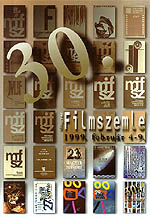 |
Vol 0, No 29
12 April 1999 |
|
|
Looking Back (Part II) Can Togay's Egy tel az Isten hata mogott Andrew J Horton To read Looking Back Part I Many of the most successful film depictions of the Communist era have been through the eyes of children, their naivity and innocence helping to accentuate the unrelenting oddity of the times. Can Togay 's second feature film Egy tel az Isten hata mogott (A Winter behind God's Back, 1997-98), set in an isolated mountain village, exploits the youthful dreams of two teenagers to paint a portrait of that most significant year in modern Hungarian politics - 1956. Radi's best friend Ladu insists that they live somewhere in Europe, but this only leads Radi to conclude that Ladu is severely mistaken. A local idiom describes something far away as being "behind God's back," and that, feels Rudi, is more like where they live. The village has one television in the local pub, but the surrounding terrain is so mountainous that all it ever shows is a swirling snowstorm of white noise. For entertainment the villagers are reliant on a motorcyclist who brings films for the cinema. One day, he fails to arrive and the villagers worst fears are confirmed when his body is found next to the wreck of his motorcycle off the edge of the highway. Ladu's father, who is the party-appointed leader of the village, has no success in galvanising the local administration into finding a replacement courier. However, it is not until winter sets in and the village innkeeper (played by award-winning Karoly Eperjes who also starred in 6:3) starts exploiting supply shortages that the villagers start getting militant. Ladu soon finds that he can earn good money with his wild imagination and story-telling talents by re-editing the remains of some old films which conveniently turn up in somebody's basement. What copies of avant-garde classics such as Battleship Potemkin and The Cabinet of Dr Caligari are meant to be doing stashed away in a mountain village is left to the viewer's imagination. A story of people The winter has an odd effect on everyone. Childhood crushes are reawakened, wanderlust is aroused and the villagers start to question the way they live. Only when spring comes do they find out about the analogous processes that have been acted out in cosmopolitan Budapest. Egy tel az Isten hata mogott wisely chooses to avoid too political an analysis of the era. Togay instead chooses to concentrate on the personal stories of his characters and leaves the more specific details of Communism and the 1956 uprising out of the frame. The politics is implied and understated, and this leaves us with a light and enjoyable film which is not bogged down by the need to explain or justify events of international significance. Indeed, the viewer who is completely oblivious to the events of 1956 will not enjoy the film or its message any less. This is a firm base on which to build a film and Togay should be congratulated for founding his film so heavily on individual characters and their personal stories rather than aiming at some grandiose statement to which the actors are subordinate. However, this still leaves Togay some room for error. His characters are too shallow and one-sided. They are either black or white, and they are devoid of the inner subtleties and plays of conflicting forces which make life so rich a tapestry. Instead, Togay's bland and plodding protagonists try their best to charm us with their heart-breaking stories of inner suffering. To some extent, they do succeed, aided by a strong cast, but the overall effect is that of a rather unoriginal fairy-tale for adults. It is truly a sad reflection of the state of Hungarian cinema that this was, in fact, one of the better films at the 30th Hungarian Film Week. Its status as a film depicting the Communist years through the eyes of youth and the film's strong grounding in story-telling - both in execution and in the film's own subject matter - mean that Egy tel az Isten hata mogott is likely to be making appearances at one or two other film festivals around the world. If it does show up near you, there are worse ways to kill time. Andrew J Horton, 12 April 1999
|
| |||||||||||||||
![]()
Copyright (c) 1999 - Central Europe Review and Internet servis, a.s.
All Rights
Reserved
